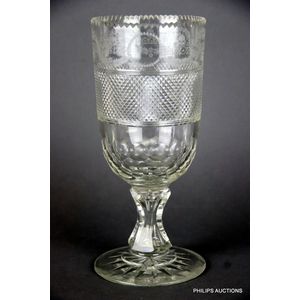Victorian Etched Glass Celery Vase
You must be a subscriber, and be logged in to view price and dealer details.
Subscribe Now to view actual auction price for this item
When you subscribe, you have the option of setting the currency in which to display prices to $Au, $US, $NZ or Stg.
- Frieze - An architectural term denoting the flat, shaped or convex horizontal surface of furniture, between the architrave and the cornice, usually found on a cabinet or bookcase, or on desks and tables where it may include drawers, the area between the top and the legs. In ceramics, the term refers to the banding, of usually a repeating pattern, on the rims of plates and vases.
- Cartouche - An ornamental panel in the form of of a shield, oval or rectangular scroll with curling edges. It may be carved into the back of a chair or the top of a sideboard, or present on a piece of silver or jewellery, and contain the initials of the original owner, heraldic symbols, or some other inscription, such as the details of a presentation.
In ceramics the term defines the central area of a vase or similar with a decorative border in one of the shapes above, into which a decorative scene or figures have been painted. - Victorian Period - The Victorian period of furniture and decorative arts design covers the reign of Queen Victoria from 1837 to 1901. There was not one dominant style of furniture in the Victorian period. Designers used and modified many historical styles such as Gothic, Tudor, Elizabethan, English Rococo, Neoclassical and others, although use of some styles, such as English Rococo and Gothic tended to dominate the furniture manufacture of the period.
The Victorian period was preceded by the Regency and William IV periods, and followed by the Edwardian period, named for Edward VII (1841 ? 1910) who was King of the United Kingdom and the British Dominions and Emperor of India for the brief period from 1901 until his death in 1910. - Etched - Glass decorated with an etched design, which is achieved through marking out the pattern, protecting the area that is not be etched, and then immersing the object in acid to dissolve the surface of the unprotected area. With some glass objects, such as cameo glass, there may be several layers of different coloured glass, and part of the top layer is dissolved leaving the bottom layer as the background. The longer the time of exposure of the object to acid, the deeper the etching.
The word etching is also sometimes used to describe another method of decoration, where wheel grinders were used decorate the surface, but this technique is usually known as engraving. - Cut Glass - Cut glass is glassware decorated with facets, grooves and depressions of various sizes and shapes, made by cutting into the surface of the glass using a rotating abrasive wheel. The glass is ground so the surface consists of facets, which have a high degree of light refraction, so that the surface sparkles.
The techniques of glass cutting had been known since the 8th century BC, and the practice was revived in Bohemia and Germany in the early part of the 16th century and in England in the 18th century. Cutting became the most common method of decorating glass in the second half of the 18th century and the early 19th century.
This item has been included into following indexes:
Visually similar items

A set of eight Waterford champagne flutes, released 1971, 'Curraghmore' pattern, made in Ireland, fine stemware with cut panels and knopped and faceted stems to a plain foot; with Waterford stencils and original boxes. Height 20.5 cm

A large coloured glass Georgian goblet, circa 1790, in lemon, with a slightly everted rim, a waisted conical base with knop to a conical foot with a rough pontil. Height 19 cm

Victorian glass goblet, air twist stem, gilt rim, engraved decoration 'Overdrevs Garden 1868-1893'. Approx 23.5 cm high

A French glass Baccarat style compote, the elegant compote with everted straight sides, decorated with vertical navette border, a knopped stem to a flat circular base, unmarked, height 18 cm, diameter 19.5 cm
